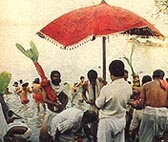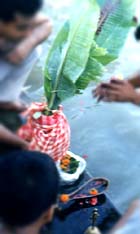 |
| a home away from home |
| HOME FEEDBACK TELL A FRIEND WEB SITE DESIGN CAREER WITH US CONTACT US |

Popularly known as Lord Ganesh's wife, Kolabou in reality has no relationship with Ganesh. Our scriptures call her Nabapatrika. Interestingly enough, Nabapatrika was actually a popular ritual performed by the peasant folks for prosperous harvest. As idol worship was not common then, people worshipped Mother nature. It was during the autumn (Sharat), the time for reaping crops ("Amondhan"), peasants worshipped Goddess Nabapatrika for good harvest.
Later when Durga Puja became a popular festival of "Sharat", all the nine holy rituals of the Nabapatrika, were added to the ceremonies of Durga Puja. Infact Nabapatrika represented the primitive form of Durga Puja. This primitive form of worship is still prevalent in some places.
Nabapatrika_____________________________________________
The nine plants comprising
Nabapatrika are:
Banana
plant "Kola Gaach"
Colacassia plant " Kochu Gaach"
Turmeric plant " Halud Gaach"
Jayanti tree
Wood apple tree " Bel Ghaach"
Arum plant "Maankochu"
Rice plant
Ashoka tree
Nabapatrika being an important part of Durga Puja, is worshipped during Bodhon. The nine plants of Nabapatrika represent the nine Goddesses.The Banana plant or the "Kola Gaach" represents
|
Goddess Brahmani, Colacassia plant represents Goddess Kalika, Turmeric plant symbolises Devi Durga, Jayanti denotes Kartiki, Bel or wood apple Goddess Shiva, Pomegranate (Dalim Gaach) Raktadantika, Ashoka tree symbolises Sokrahita and Arum plant ("Maankochu") represents Chamunda and the Rice plant Goddess Lakshmi. These Goddesses are the nine forms of Devi Durga. |
Bathing
Ritual______________________________________
In the
early hours of Saptami, the twigs of white "aparajita" plant
along with nine bunches of yellow threads are used to tie the Nabapatrika.
It is then bathed. In our scriptures the elaborate bathing ritual of nabapatrika
is compared with the coronation of a King. Just like the King is bathed
with waters from holy places and oceans, bathing nabapatrika too requires
the same. All the nine Goddesses representing nabapatrika are bathed with
waters from 8 different holy places. This bathing ritual is accompanied
with varied mantras and diverse musical instruments for different goddesses.
The Holy
Waters and The Ragas_______________
The first pot holds
the holy water of the Ganges which is accompanied with Malob Raga.
The second pot holds rain water which is accompanied with Lalit Raga.
The third pot holds water from river Saraswati which is accompanied with
Vibhash Raga with Dundhabi beats. The fourth pot holds ocean water which
is accompanied with Bhairavi Raga with Bhim beats. The fifth pot holds
mixture of Lotus pollen in holy water which is accompanied with Gaur Raga
and mahendrabhishek beats. The sixth pot holds spring water which is

accompanied with Barari Raga and sound of conch shell. The seventh pot holds water from all holy places which is accompanied with Vasant Raga and sound of conch shell. The eighth pot holds holy water which is accompanied with Dhanshirag Raga and Bhairavi beats.

An Elaborate Affair In The Babu Era______
Earlier
the bathing ritual of Nabapatrika was an elaborate affair for the Babus.
Long processions accompanied with musical instruments and much fanfare
was common then. With idol worship gaining ground, nabapatrika slowly
lost its importance. The bathing ritual is a small affair now. Water
from the Ganges or some nearby pond accompanied with Dhak and Kanshi finishes
of the ceremony which was once a very lengthy affair.
After the bathing ceremony Nabapatrika is adorned
in red bordered white saari and vermilion is smeared on its leaves. She
is then placed on a decorated pedestal and worshipped with flowers,
sandalwood paste and incense sticks. Later she is placed on the right
side of Lord Ganesh. This is the reason she is popularly known as Ganesh's
wife.
GREAT INDIANS || BENGALI SECTION || BENGALI MARRIAGE || BABY'S NAME || WALLPAPER || BENGAL || WEATHER || TRAVEL
MOBILE WALLPAPER || E-CARD || MOVIE || WEBSITE LINKS || ASSOCIATIONS || SHOPPING || ASTROLOGY || MUSIC || BEAUTY CARE
TIGER || NEWS || GUEST CORNER || FEEDBACK || LINK TO US || FOR ADVERTISING || SERVICES || CONTACT || BENGALI CALENDAR
Graphics, Sound or content copied or produced in part or whole in any media will be illegal.
Persons or websites caught using our material will be penalized.
Privacy Statement || Copyright
Copyright ©1999-2014 BANGALINET.COM